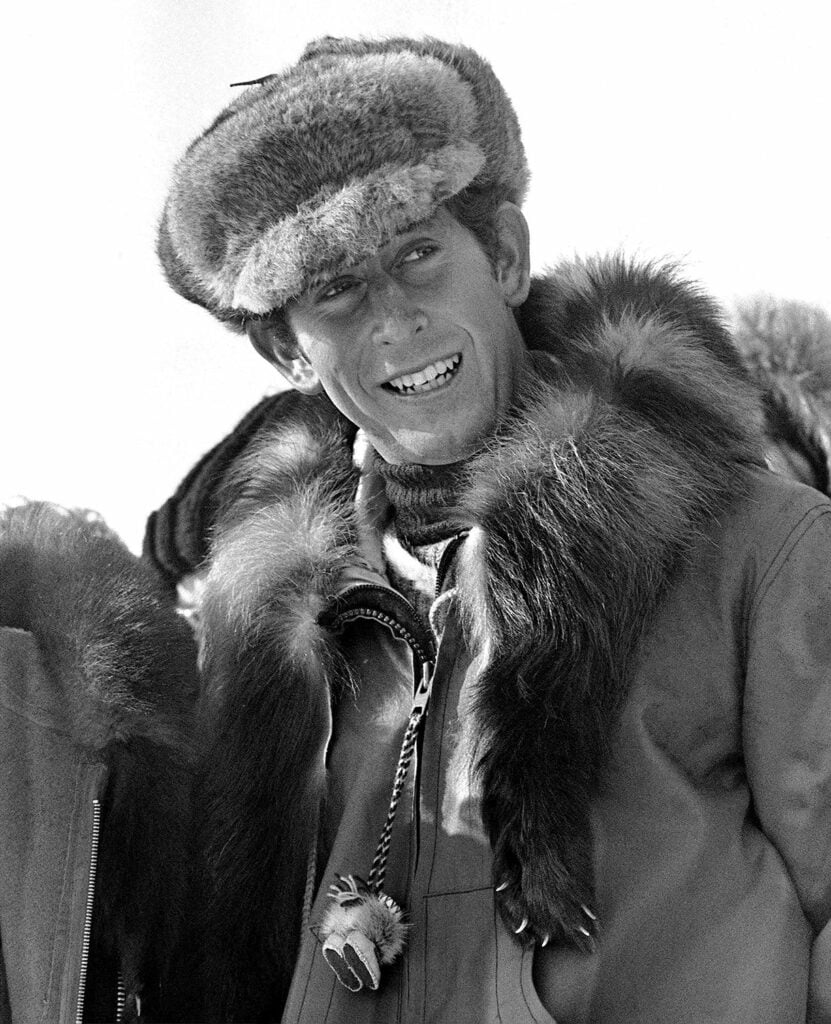
Travel
How to stop a gold rush
The new movement building flourishing tourism hubs across Canada – one sustainable example at a time
- 3297 words
- 14 minutes
Exploration
Remembering a 1975 journey under the ice of the Northwest Passage with King Charles III

I’m trying to read the mind of the 26-year-old Englishman in front of me, searching for signs of anxiety. His Royal Highness Prince Charles, Prince of Wales, Earl of Chester, Duke of Cornwall, Duke of Rothesay, Earl of Carrick, Baron of Renfrew, Lord of the Isles and Prince and Great Steward of Scotland has achieved many things in his rich and royal life, but this is the first time he’s dived under a fathom of ice in near-freezing water.
We’re 700 kilometres north of the Arctic Circle, sitting on the edge of a square-cut dive hole. The ice is almost two metres thick. Sea water filling the hole is studded with ice crystals. We’re sitting inside a heated canvas tent, wearing red neoprene diving suits. The temperature outside the double-walled tent is -33 C. The temperature inside is 5 C. As I explain to the prince how to inflate the suit, his eyebrows arch into an unspoken question. Can I trust this man?
The polar ocean in front of us is freighted with perils. Acute hypothermia from a leaking dive suit. Air embolism caused by breath-holding during ascent. The remote “black swan” possibility of the ice shifting and closing over our heads. We’re in Qausuittuq (Resolute), a small Inuit hamlet on the north shore of the Northwest Passage. Since arriving here, the prince has been under the tight-lipped scrutiny of his British and Canadian security team. Their primary task is to analyze any threats against his life and take steps to protect him. They are uneasy. A few minutes from now, the prince will descend into a life-threatening environment and leave them behind.
The prince’s itinerary on this visit to Arctic Canada includes dogsledding, snowmobiling and this dive. As a physician-scientist and undersea explorer, it’s my job to make sure the prince stays safe. Yesterday I had a conversation with a senior member of his Scotland Yard protection team. His eyes moved all the time; his body bristled with energy. Beyond the words of our conversation was an unspoken message: if the prince returns with a single hair out of place, there will be trouble — sudden and serious.
From his first breath, the man in the red suit beside me has led a preordained life. He was born for one job and one job only: heir to the throne. At six, he was shy and prone to sinus infections. At eight, he was shipped off to board at Cheam School, a prep school for royals and elites. During rugby games, his teammates and opponents pummelled him in the scrum. He was stoic; he never fought back. Prince Philip thought his son needed courage and character and sent him to his own alma mater Gordonstoun, a spartan Scottish boarding school founded on the promise of freeing “the sons of the powerful” from “the prison of privilege.” The future king was a prime target for bullies. When he wasn’t beaten up, he was ostracized.
This afternoon, the man in the shadow of the throne shows no evidence of these early adversities. His eyes are attentive; he’s full of questions. I show him a thin neoprene hood that looks like a ski mask. “This hood protects the skin on your face from freezing,” I tell him.
“Why is that important?” he asks.
“If the skin around your mouth gets cold,” I tell him, “you’ll have trouble holding your breathing regulator in place.”
I imagine what might happen. His mouthpiece slips out. Thick neoprene gloves try to jam it back in between his teeth. Breathing rate increases. Panic follows.

The prince is almost ready. A metal harness carrying two high-pressure air cylinders is eased onto his back. He tightens its straps around his waist. He checks his breathing regulator by inhaling and exhaling through its mouthpiece. He cleans off his face mask. His practised way with these procedures confirms his numerous dives in temperate waters.
He adjusts the row of lead weights on a belt around his waist and looks at me. “This weight-belt is very heavy,” he says.
“The belt weighs 50 pounds,” I tell him. “The first 25 pounds is to overcome the buoyancy of your inflatable suit. The second 25 pounds is to overcome reluctance.” He responds with a half-smile.
He puts the mouthpiece of his breathing regulator between his teeth, inhales, pushes off from the insulated floor and slides into the water. After bobbing for a few seconds in the ice crystals, he presses the exhaust button in his suit and sinks. The neoprene glove on his right hand has a firm grip on the yellow line hanging in the dive hole. He will wait for me beneath the ice.
I slip into the water and check my breathing regulator. A member of the Scotland Yard protection team looks at me with eyes that have squinted the length of a gun barrel.
I exhale and descend into the chimney of ice. It took most of an afternoon to cut the hole and remove two tonnes of frozen water. The sides of the chimney have the patina of old ivory.
I ease my way down the chimney, beneath the ice, and come face to face with the prince in crystal clear water. I’m hyper-vigilant for a multitude of signs that will keep my partner whole and bring him safely back to the surface. In this airless, voiceless world, I focus on three things: breathing rate, eye movement, body language. His breathing rate is paced. His eyes are locked on mine. His fins move easily in the water beneath him.
This is my homeland, a place I regard with deep suspicion. The ceiling of ice splaying out to invisible horizons. A tangle of kelp covering the sea floor. Water so cold it kills an unprotected diver in minutes. Five years before, I led the first of four expeditions to this bay. Our objective was to develop techniques to allow scientists to work safely beneath the ice. Supported by the Canadian government, we made more than 800 dives in this cove and other polar regions. Last year, not far from where we’re swimming, we constructed Sub-Igloo, the first staffed polar station. The station was a transparent acrylic sphere, filled with air, that was big enough to accommodate three divers on a circular bench. Its entry and exit hatch was a small, round opening in the floor. Air pressure inside the sphere kept the ocean at bay. Sixteen struts connected the sphere to ballast trays. For six weeks, Sub-Igloo was our refuge and science centre.
A diver appears out of the blackness behind the prince. It’s Rick Mason, one of the most trusted members of our team, and he’s carrying a 35mm camera with a strobe light.
The prince struggles to control the air in his suit. He adds too much and his head bumps hard against the ice. He presses the exhaust button and sinks too quickly. His steady breathing confirms that he’s unflustered as he wrestles with the unalterable principles of buoyancy.
I scan the dimensions of our claustrophobic realm. The undersurface of the ice looks like a storm cloud restraining mercury-like pools of our exhaust air. The vertical vault of water distorts the near and far of things. Once the prince has his buoyancy under control, I motion for him to follow. Slowly, we head west, keeping the ice above our heads. I point down to the shadowy piles of steel ballast that once held Sub-Igloo to the sea floor.
A few minutes later, we encounter the first ice stalactite, a hollow tapering tube as long as a forearm, hanging from the ice. It encloses a plume of descending brine filled with a community of life including diatoms and algae. The most visible creatures are tiny, brown crustaceans called amphipods. The prince looks at the amphipods for a long time and gazes up at the ceiling of ice. Later, he tells me that “every mountain and river has an almost sacred character of its own.”

We continue west until we encounter a ridge of shore-fast ice. In the feeble twilight, we stare at broken blocks lying at harsh angles. It is a starkly forbidding place of fissures and corrugations. The prince is looking at ice as cold and malevolent as beauty can be.
I check my watch. Twenty-five minutes have elapsed; it’s time to swim back to the dive hole. In the celestial light, a lion’s mane jellyfish trails a skein of stinging tentacles. I turn a slow, 360-degree circle to see if anything is watching. So far, we’ve avoided the evil luck of a Greenland shark. They live in deep water but visit the shallows. Slow-moving carnivores, they reach lengths of six metres. A few have been found with caribou and human bones in their stomachs. The fact that we’ve not seen them in this bay has never been comforting.

When the dive hole is almost above us I give a short wave to Rick Mason, who slides in beside the prince. I drop to the sea floor and search for two items I put there previously. With clumsy hands I dust them off and put them in position. Then I float up until I’m just behind the prince. Gently, I tap him on the shoulder. He turns around to see me wearing a black bowler hat and holding an unfurled umbrella. He stares at me as if I’ve gone mad. My heart sinks. Seconds later, his eyes crinkle and the sound of muted laughter fills the space between us. My God, I think, he’s going to inhale the ocean.
The prince puts the hat on, reaches for the umbrella, holds it over his head and slowly ascends toward the dive hole. Trailing a stream of bubbles, he is Mary Poppins in the flying nanny scene.
The faces greeting him in the tent are stupefied. There’s no logical explanation for a grinning prince surfacing in a bowler hat. The shock is followed by laughter.
After wiping his face and adjusting his hat, the man who lives his life under the camera’s unblinking eye steps out of the tent to face a scrum of reporters and photographers. Before leaving the tent, he inflated his suit, making him look like the Michelin Man. He lifts his arms up in a victory salute and rises up on his toes. There is laughter and applause.
He steps into the centre of the scrum and pats his enormous stomach.
“How was it?” someone asks. “Very interesting, indeed. Bloody cold,” he laughs. “How was the suit?” someone else asks. “Well, you put the air in here,” he says, “and you can do amazing things.”
He presses the exhaust button and holds it. His arms and shoulders go limp. His head leans forward until his chin touches his chest.
He continues until he’s almost doubled over.
My heart is slowing. The prince is safely on the surface.
In the feeble twilight, we stare at broken blocks lying at harsh angles. The prince is looking at ice as cold and malevolent as beauty can be.
ALMOST A DECADE LATER, in July, 1984, I find myself in Kensington Palace, London, in the office of the personal assistant to the Prince of Wales.
The lieutenant-colonel asks, “Are you ready? He’ll be here in five minutes.”
It has taken a series of interlocking events to be here. A five-year search for a 19th-century British shipwreck 90 kilometres east of where the prince made his 1975 dive. The discovery of the Breadalbane in 100 metres of water. The construction of a 20-person base camp that allowed us to make 10 dives to film the 1853 wreck. An almost-completed documentary about the project, The Land That Devours Ships, directed by Bill Mason for the National Film Board.
Six months ago, I sent a letter to the prince asking if he might consider introducing the film. In a letter from Buckingham Palace, his private secretary wrote back: “His Royal Highness would be happy to contribute to your film. It would be helpful if you could let us have a draft of what the Prince of Wales might say. His Royal Highness would then like to see the film before deciding on the form of his introduction.”
I check to make sure the lights are in place, the sound equipment tested. The film’s director, Bill Mason, gives me an affirmative nod. “We’re ready,” I say.
The door opens, and the prince enters the room. He’s wearing a double-breasted grey suit and smiling. We exchange greetings, and I introduce him to the members of our four-person documentary film team.
“I’m sorry, I’ve only got 40 minutes,” he says, “so we should get started.”
Standing behind a model of a 19th-century three-masted ship, he faces the camera. “I’m ready,” he says. “Let’s see if I have the talent to make this work.”
“Camera rolling,” says the cinematographer. The prince begins. “More than a century ago, ships like this one sailed out from England and into the Canadian Arctic in search of the Northwest Passage. Having served in the Royal Navy myself for a few years, I think I can imagine, just a little bit, about what it must have been like to be on board a ship like this, crossing the cold North Atlantic in those terrible stormy seas. And fighting one’s way through those ice-choked islands.”
His voice is warm and humble. “A few years ago, I was lucky enough to visit the Canadian Arctic and to dive under the ice with Dr. Joe MacInnis. That was one of the most interesting and exciting things I have done for a considerable time. It was that particular experience that helped me to discover why so many of those ships never came back from the great expeditions of the 19th century. It was the loss of two of those ships, the Erebus and Terror, under the command of Sir John Franklin, that launched the greatest search in maritime history. And it’s a search that’s continuing even today.”

We record two more versions. The prince inhabits every word.
“I really enjoyed seeing your film,” he says after we finish. “It gave me a clear understanding of the unpredictable ice and the challenges you faced. I wish I could have joined you, but it was impossible.”
We sit down for tea and a short conversation. He’s full of questions. The lieutenant-colonel reminds the prince of his other commitments.
“I’m sorry, I must go now,” says His Royal Highness. “Please stay and help yourselves to a drink.”
He motions to a large liquor cabinet at the end of the room.
“Thank you, sir, we will.”
We shake hands and I tell the prince how grateful I am for his contribution. Then he and the lieutenant-colonel leave the room.
It is dangerous to tell a small team of filmmakers “to help yourself to a drink.” Spoken by a future king, it is a directive. Then it becomes a personal challenge. We open the liquor cabinet and help ourselves to generous glasses of rare, aged whiskey and cask-strength rum.
After two glasses, we walk into the hot July sunshine. I say goodbye to my colleagues and head towardſ Round Pond, an ornamental lake in Kensington Gardens. I stop to admire its shimmering view of the palace, then continue toward the Serpentine and follow its western shore until I come to the statue of Peter Pan. It celebrates a free-spirited boy who flies and never grows up — a boy who spends his everlasting childhood having adventures with pirates, fairies and mermaids.
The nine years following our Arctic dive were a challenge for the prince. The perpetual agenda of royal responsibilities. The hunt for a personal identity. The search for a royal wife. The relentless scrutiny of the tabloid press. In 1979, in the explosion of an Irish Republican Army bomb, the prince lost his beloved great-uncle and confidant, Lord Mountbatten.
One of the best things about diving is that nothing exists of the world except your thoughts about the ocean and the person you are with. King Charles is someone whose deep blue eyes and inquiring mind have their own unique depths. He pays close attention to the people around him, the nation and the shifting social terrain. He communicates with words and actions that are accurate, clear and clever. During a time of failing natural and social systems, he’s curious and courageous, focusing on projects that help people and places that are worthy and in need.
Wherever he is, even under the ice, he carries the fire.
Are you passionate about Canadian geography?
You can support Canadian Geographic in 3 ways:

This story is from the May/June 2023 Issue

Travel
The new movement building flourishing tourism hubs across Canada – one sustainable example at a time

People & Culture
As the climate heats up, so do talks over land ownership in the Arctic. What does Canadian Arctic Sovereignty look like as the ice melts?

Travel
Un nouveau mouvement créateur de pôles touristiques florissants dans tout le Canada – la durabilité, un exemple à la fois

Environment
The uncertainty and change that's currently disrupting the region dominated the annual meeting's agenda